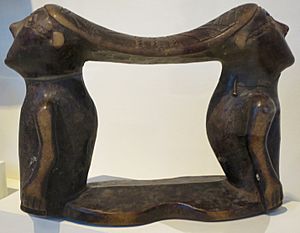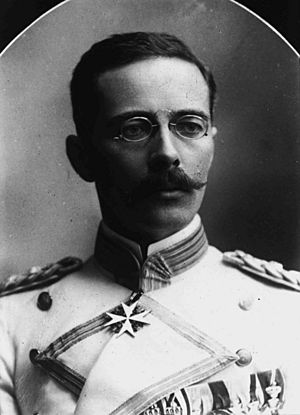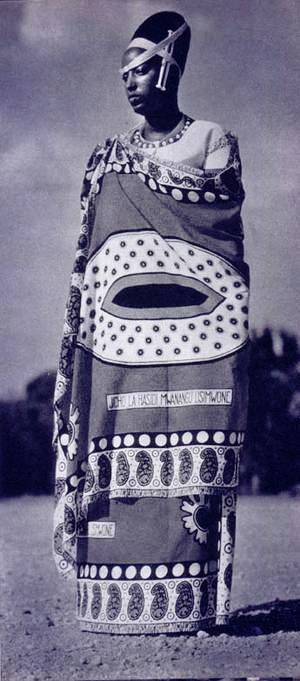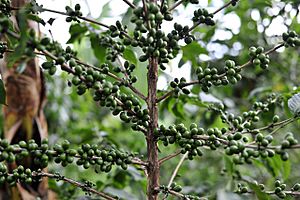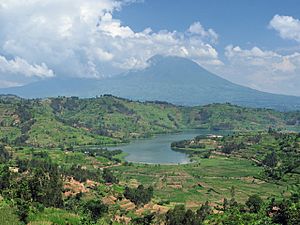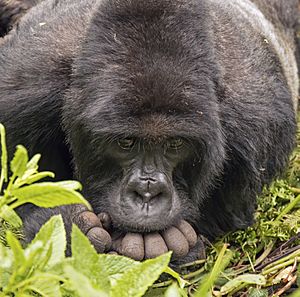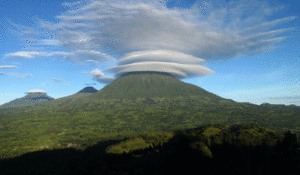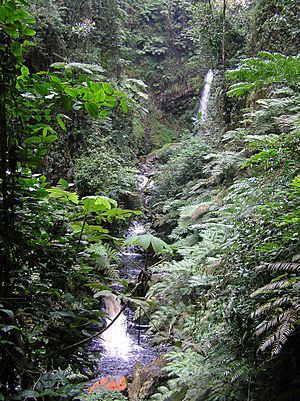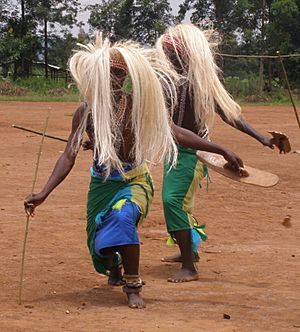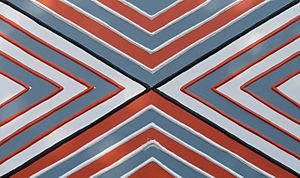Rwanda facts for kids
Quick facts for kids
Republic of Rwanda
|
|
|---|---|
|
|
|
|
Motto: "Ubumwe, Umurimo, Gukunda Igihugu"
(English: "Unity, Work, Patriotism") (French: "Unité, Travail, Patriotisme") (Swahili: "Umoja, Kazi, Uzalendo") |
|
|
Anthem: "Rwanda Nziza"
(English: "Beautiful Rwanda") |
|
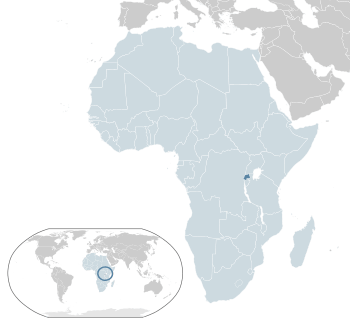
Location of Rwanda (dark blue)
in Africa (light blue) |
|
| Capital and largest city
|
Kigali 1°56′38″S 30°3′34″E / 1.94389°S 30.05944°E |
| Official languages |
|
| Ethnic groups
(1994)
|
|
| Religion |
|
| Demonym(s) |
|
| Government | Unitary presidential republic under an authoritarian dictatorship |
| Paul Kagame | |
| Édouard Ngirente | |
| Legislature | Parliament |
| Senate | |
| Chamber of Deputies | |
| Formation | |
|
• Kingdom of Rwanda
|
15th century |
|
• Part of German East Africa
|
1897–1916 |
|
• Part of Ruanda-Urundi
|
1916–1962 |
|
• Rwandan Revolution
|
1959–1961 |
|
• Republic declared
|
1 July 1961 |
|
• Independence from Belgium
|
1 July 1962 |
|
• Admitted to the UN
|
18 September 1962 |
|
• Current constitution
|
26 May 2003 |
| Area | |
|
• Total
|
26,338 km2 (10,169 sq mi) (144th) |
|
• Water (%)
|
6.341 |
| Population | |
|
• 2024 estimate
|
13,623,302 (76th) |
|
• Density
|
517/km2 (1,339.0/sq mi) (22nd) |
| GDP (PPP) | 2023 estimate |
|
• Total
|
|
|
• Per capita
|
|
| GDP (nominal) | 2023 estimate |
|
• Total
|
|
|
• Per capita
|
|
| Gini (2016) | 43.7 medium |
| HDI (2022) | low · 161st |
| Currency | Rwandan franc (RWF) |
| Time zone | UTC+2 (CAT) |
| Date format | dd/mm/yyyy |
| Driving side | right |
| Calling code | +250 |
| ISO 3166 code | RW |
| Internet TLD | .rw |
Rwanda, officially the Republic of Rwanda, is a country in Central and East Africa and one of the smallest countries on the African mainland. Located a few degrees south of the Equator, Rwanda is bordered by Uganda, Tanzania, Burundi and the Democratic Republic of the Congo. The population is young and predominantly rural, with a density among the highest in Africa. The name "Rwanda" is derived from the Rwanda-Rundi word rwanda meaning "domain" or literally an "area occupied by a swarm".
Rwandans are drawn from just one cultural and linguistic group, the Banyarwanda, although within this group there are three subgroups: the Hutu, Tutsi and Twa. The Twa are a forest-dwelling pygmy people descended from Rwanda's earliest inhabitants.
Contents
History
Hunter gatherers settled the territory in the stone and iron ages, these early inhabitants were the ancestors of the Twa, aboriginal pygmy hunter-gatherers who remain in Rwanda today. Between 700 BC and 1500 AD, a number of Bantu groups migrated into Rwanda, clearing forest land for agriculture. The forest-dwelling Twa lost much of their habitat and moved to the mountain slopes.
From the 15th century, the clans began to unite into kingdoms; by 1700 around eight kingdoms existed in present-day Rwanda. One of these, the Kingdom of Rwanda, ruled by the Tutsi Nyiginya clan, became increasingly dominant from the mid-eighteenth century.
Colonization
The Berlin Conference of 1884 assigned the territory to Germany as part of German East Africa, marking the beginning of the colonial era. The explorer Gustav Adolf von Götzen was the first European to significantly explore the country in 1894 and eventually met the king. The Germans did not seriously alter the social structure of the country, but used their influence by supporting the king and the existing leaders and assigning power to local chiefs.
Belgian forces took control of Rwanda and Burundi in 1916, during World War I, beginning a period of more direct colonial rule. Belgium ruled both Rwanda and Burundi as a League of Nations mandate called Ruanda-Urundi. The Belgians also simplified and centralised the power structure, and introduced large-scale projects in education, health, public works, and agricultural supervision, including new crops and improved agricultural techniques to try to reduce the incidence of famine.
Both the Germans and the Belgians promoted Tutsi supremacy, considering the Hutu and Tutsi different races. In 1935, Belgium introduced identity cards labelling each individual as either Tutsi, Hutu, Twa or Naturalised. While it had previously been possible for particularly wealthy Hutu to become honorary Tutsi, the identity cards prevented any further movement between the classes.
Belgium continued to rule Ruanda-Urundi (of which Rwanda formed the northern part) as a UN Trust Territory after the Second World War, with an official order to oversee eventual independence. Tensions escalated between the Tutsi, who favoured early independence, and the Hutu freedom movement, which bought about the 1959 Rwandan Revolution. Hutu activists began killing Tutsi and destroying their houses, forcing more than 100,000 people to seek refuge in neighbouring countries.
In 1961, the Belgians held a referendum in which the country voted to formally put an end to the monarchy. Rwanda was separated from Burundi and gained Independence on 1 July 1962. Cycles of violence followed, with exiled Tutsi attacking from neighbouring countries and the Hutu retaliating with large-scale slaughter of the Tutsi. They massacred numerous Tutsi and ultimately established an independent, Hutu-dominated state in 1962.
In 1973, Juvénal Habyarimana took power. Pro-Hutu discrimination continued, but there was greater economic prosperity and a reduced amount of violence against Tutsi. The Twa remained marginalised, and by 1990 were almost entirely forced out of the forests by the government; many became beggars. Rwanda's population had increased from 1.6 million people in 1934 to 7.1 million in 1989, leading to competition for land.
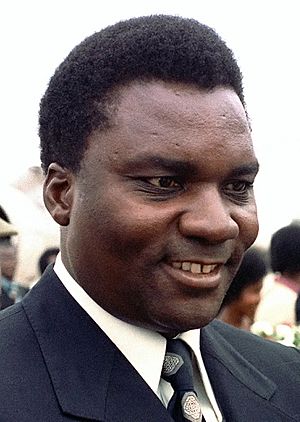
In 1990, the Rwandan Patriotic Front (RPF), a rebel group composed of nearly 500,000 Tutsi refugees, invaded northern Rwanda from their base in Uganda, which started the Rwandan Civil War. The group condemned the Hutu-dominated government for failing to confront the problems facing these refugees. Neither side was able to gain an advantage in the war, but by 1992 it had weakened Habyarimana's authority; mass demonstrations forced him to sign the 1993 Arusha Accords with the RPF.
The cease-fire ended on 6 April 1994 when Habyarimana's plane was shot down near Kigali Airport, killing him. The shooting down of the plane served as the beginning of the Rwandan genocide, which began within a few hours. Over the course of approximately 100 days, around 800,000 Tutsi and Hutu were killed in well-planned attacks on the orders of the temporary government. Many Twa were also killed. The Rwandan Patriotic Front ended the genocide with a military victory.
Politics
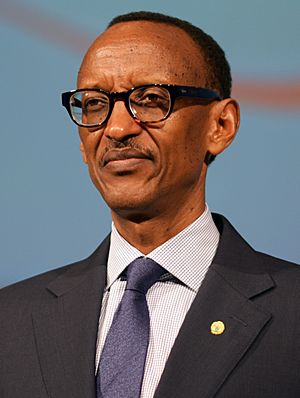
The sovereign state of Rwanda has a presidential system of government. The country has been governed by a strict administrative hierarchy since precolonial times; there are five provinces. Rwanda is one of only two countries with a female majority in the national parliament.
Economy
Rwanda's economy suffered heavily in the wake of the 1994 genocide, but has since strengthened. Since 2000 Rwanda's economy, tourist numbers, and Human Development Index have grown rapidly; between 2006 and 2011 the poverty rate reduced from 57% to 45%, while life expectancy rose from 46.6 years in 2000 to 59.7 years in 2015.
The economy is based mostly on subsistence agriculture. Farming techniques are basic, with small plots of land and steep slopes. Since the mid-1980s, farm sizes and food production have been decreasing, due in part to the resettlement of displaced people. Despite Rwanda's fertile ecosystem, food production often does not keep pace with population growth, and food imports are required.
Crops which are grown for ones self and family in the country include matoke (green bananas), which occupy more than a third of the country's farmland, potatoes, beans, sweet potatoes, cassava, wheat and maize. Coffee and tea are the major cash crops for export, with the high altitudes, steep slopes and volcanic soils providing favourable conditions. Reports have established that more than 400,000 Rwandans make their living from coffee plantation.
Geography
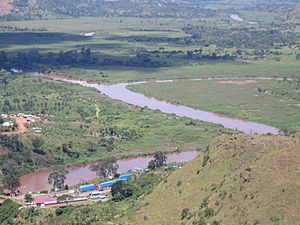
At 26,338 square kilometres (10,169 sq mi), Rwanda is the world's 149th-largest country. The entire country is at a high altitude. The lowest point is the Rusizi River at 950 metres (3,117 ft) above sea level. Rwanda is in Central/Eastern Africa. It is bordered by the Democratic Republic of the Congo to the west, Uganda to the north, Tanzania to the east, and Burundi to the south. It is a few degrees south of the equator and is landlocked. The capital, Kigali, is near the centre of Rwanda.
The country's longest river is the Nyabarongo. Rwanda has many lakes, the largest being Lake Kivu. It is one of the twenty deepest lakes in the world. Other sizeable lakes include Burera, Ruhondo, Muhazi, Rweru, and Ihema. Ihema is the largest of a string of lakes in the eastern plains of Akagera National Park.
There are many mountains in central and western Rwanda. The highest peaks are found in the Virunga volcano chain in the northwest. This includes Mount Karisimbi, Rwanda's highest point, at 4,507 metres (14,787 ft). The centre of the country is mostly rolling hills. The eastern border area has savanna, plains and swamps.
Rwanda has a temperate tropical highland climate. There is little change through the year. There are two rainy seasons in the year, the first runs from February to June and the second from September to December. These are separated by two dry seasons,the major one is from June to September, during which there is often no rain at all.
Biodiversity
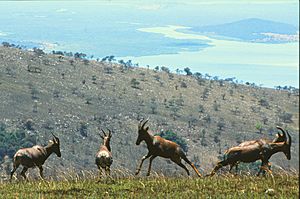
In prehistoric times montane forest occupied covered one third of the land of present-day Rwanda. Naturally occurring vegetation is now mostly in the three National Parks, with terraced agriculture in the rest of the country. Nyungwe, the largest remaining forest, has 200 species of tree as well as orchids and begonias. Vegetation in the Volcanoes National Park is mostly bamboo and moorland, with small areas of forest. Akagera has a savanna ecosystem. Here there are mostly acacia. There are several rare or endangered plant species in Akagera.
The greatest diversity of large mammals is found in the three National Parks. Akagera has typical savanna animals such as giraffes and elephants, while Volcanoes is home to about one third of the worldwide mountain gorilla population. Nyungwe Forest has thirteen primate species including chimpanzees and Ruwenzori colobus arboreal monkeys. The Ruwenzori colobus move in groups of up to 400, the largest troop size of any primate in Africa. There are 670 bird species in Rwanda. A recent discovery in the country has revealed a rich diversity of praying mantises.
Tourism
In spite of the genocide's legacy, the country is increasingly perceived internationally as a safe destination. Rwanda has come a long way since the civil war and genocide of 1994 devastated this tiny country. Shake off your memories of war and expect a warm and friendly welcome to a beautiful country.
Rwanda is not only the land of a thousand hills, but also a country rich in flora and fauna and stunning natural beauty in its scenic rolling and breathtaking green savanna. Tourism is one of the fastest-growing economic resources and became the country's leading foreign exchange earner in 2007.
The largest contributor to this revenue was mountain gorilla tracking, in the Volcanoes National Park. Rwanda is one of only two countries in which mountain gorillas can be visited safely. The gorillas attract thousands of visitors per year, who are prepared to pay high prices for permits. Other attractions include Nyungwe Forest, home to chimpanzees and other primates, the resorts of Lake Kivu, and Akagera, a small savanna reserve in the east of the country. It also has the world's largest natural park for hippos - some 20,000 are believed to be there.
Thin plastic bags are prohibited in Rwanda. Luggage will be searched at the border and even at police checkpoints throughout the country to make sure you are not carrying plastic bags. Prior to the ban, one-time use plastic bags plagued city streets and threatened the delicate environment. Today, Rwandan cities are almost litter-free and some of the cleanest in Africa.
Some popular tourists places are;
- Volcanoes National Park: This Park is a haven of the famous and unique critically endangered mountain gorillas.
- Akagera National Park: The fascinating attractions that are worth visiting in this park include a network of lakes including Lake Ihema. This savanna park is widely known for game viewing because of the variety of wildlife species.
- Nyungwe forest National Park: 75 species of mammals are inhabited in this park including 13 primate species and the park is a home of over 300 species of birds. There is a fascinating canopy walk. Several hiking trails include the Ngabwe trail, Bigugu trail, Kamiranzovu marsh trail, and Isumo waterfall trail.
- Kigali city tour: Kigali was declared Africa’s most beautiful city by the United Nations, it is one of the cleanest and safest places in Africa.
- Musanze caves: The caves are the most visited among the 52 surveyed caves in Musanze District. They about 2 km long, have 31 entrances with the main entrance being 10km wide. The Musanze caves harbor a colony of bats which also add to the memorable visitor experience.
Culture
Music and dance are an integral part of Rwandan ceremonies, festivals, social gatherings and storytelling. The most famous traditional dance is the umushagiriro, or cow dance, performed by women; the intore, or dance of heroes, performed by men; and the drumming, also traditionally performed by men. The best known dance group is the National Ballet. It was established by President Habyarimana in 1974, and performs nationally and internationally.
Traditional arts and crafts are produced throughout the country. Woven baskets and bowls are especially common. Imigongo, a unique cow dung art, is produced in the southeast of Rwanda, with a history dating back to when the region was part of the independent Gisaka kingdom. The dung is mixed with natural soils of various colours and painted into patterned ridges to form geometric shapes. Other crafts include pottery and wood carving.
Traditional housing styles make use of locally available materials; circular or rectangular mud homes with grass-thatched roofs are the most common. The government has initiated a programme to replace these with more modern materials such as corrugated iron.
Rwanda does not have a long history of written literature, but there is a strong oral tradition ranging from poetry to folk stories. Many of the country's moral values and details of history have been passed down through the generations.
Cuisine
The Rwandan cuisine is famous all over East Africa, its signature dish is Ugali and vegetables, which is a paste made from maize and water, to form a porridge-like consistency. Isombe is made from mashed cassava leaves and served with dried fish. Matoke is a dish made from baked or steamed plantains. Ibihaza is made from pumpkins cut into pieces, mixed with beans and boiled without peeling them
Rwandan food is neither spicy nor hot. People eat simple meals made with locally grown ingredients. The Rwandan diet consists mainly of sweet potatoes, beans, corn, peas, millet, plantains, cassava, and fruit. Many Rwandans do not eat meat more than a few times a month. For those who live near lakes and have access to fish, tilapia is popular. The potato, thought to have been introduced to Rwanda by German and Belgian colonialists, is also very popular.
Related pages
Images for kids
-
Volcanoes National Park is the home of the largest population of Mountain Gorillas in the world.
-
Children in a Rwandan primary school, using laptops supplied by the One Laptop Per Child program
See also
 In Spanish: Ruanda para niños
In Spanish: Ruanda para niños




